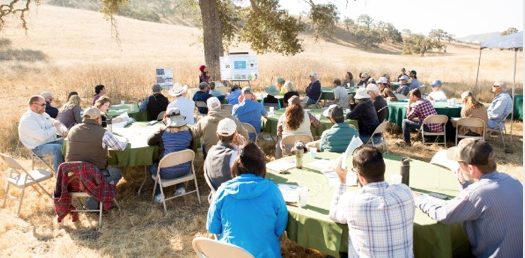Click here for the entire e-newsletter
Present uncommon opportunity for agricultural industry to benefit while reducing climate change impact
SANTA BARBARA — The Community Environmental Council (CEC), Ted Chamberlin Ranch, Cachuma Resource Conservation District, and Santa Barbara Agricultural Commissioner’s Office hosted a Healthy Soils Field Day and Compost Demonstration on Tuesday, October 23 at the Ted Chamberlin Ranch in Los Olivos.
Part of grant work funded by the California Healthy Soils Program, the field day gathered an audience of over 60 local ranchers and growers to exhibit compost application and discuss the anticipated ecological and economic results for the Ted Chamberlin Ranch.
Featuring group discussions, presentations by various partners, and hands-on demonstrations, topics included soil health science, the process of compost application on rangeland, managed grazing, vineyard and open space management, integrated pest management, and carbon farm planning. Along with broader gains of improving soil health and sequestering carbon (in soil and plants), bottom-line agricultural benefits were outlined, including increased water holding capacity and increased crop productivity.
Russell Chamberlin and his family co-manage the Ted Chamberlin Ranch, where researchers have been working over the last three years to increase soil health, drawdown atmospheric carbon, study the benefits, and demonstrate the results. He is impressed by the already apparent success of this work: “Through the application of compost and planned grazing we have been able to see a wide range of benefits in a short amount of time. At a time of increased drought and economic challenges, these benefits have huge value for our ranch, and can make a large impact on the Central Coast.”
The benefits he refers to are measurable, and have been documented by researchers through the Natural Resource Conservation Service. For instance, a one-time application of compost resulted in a “forage productivity” increase of 16% in the first year, and a 25% increase in the second year – meaning that there is more grass for Chamberlin’s cattle to eat per acre. The compost application also led to an increase in soil health metrics such as soil stability, which allows the soil to hold more water and be more productive. Chamberlin himself has seen an increase in the presence of oak saplings, which he noted is an exciting indicator of his ranch ecosystem’s health.
Granted by the California Department of Food and Agriculture (CDFA), the Healthy Soils program funds projects throughout the State, aiming to build soil carbon – effectively pulling excess carbon from the air and storing it instead in soil and plants– and reduce agricultural greenhouse gas (GHG) emissions. The hope is to replicate and demonstrate previously seen results on a wide range of crop types and acreage.
The effort to address soil health locally came in part from a blueprint established by the Santa Barbara County Food Action Plan, in addition to the “Rancher to Rancher” outreach program headed by the Cachuma Resource Conservation District.
As part of the group that helped coordinate the creation of the SBC Food Action Plan, CEC’s CEO/Executive Director Sigrid Wright stated, “What we are looking to do is support farmers and their capacity to address the changing climate. Our community’s strategic plan for the food system has taken the highly unusual path of starting at the roots by identifying soil health as one of its top goals.” Noting the region’s century-old ranchero history, she added, “Not only do these efforts to rebuild soil reduce the amount of carbon in the air, they also help the agricultural sector stay in business and maintain a centuries-old legacy. ”
Over the next three years, these types of field days will be held twice annually in support of the Healthy Soils grant objectives. These include garnering support for wide-scale adoption of carbon farming practices on agricultural land, and showing the potential for the agricultural sector to become both more resilient in the face of climate change and a leader in climate change mitigation.
Additional partners on this field day included the UC Cooperative Extension, Cal Poly San Luis Obispo, Premier Ag Inc., and Engel & Gray Inc.
To learn more about the Healthy Soils work, contact CEC’s Food and Climate Program Associate Allegra Roth at aroth@cecmail.org or (805) 963-0583 Ext. 104.
About Community Environmental Council: Since 1970, CEC has led the Santa Barbara region – and at times California and the nation – in creative solutions to some of the toughest environmental problems. CEC pioneers real life solutions in areas with the most impact on climate change. Our programs – including the annual Santa Barbara Earth Day Festival – provide pathways to clean vehicles, solar energy, resilient food systems, and reduction of single-use plastic. Our commitment to excellence has made CEC one of only five nonprofits in Santa Barbara County to earn the highest possible ratings from both Guidestar and Charity Navigator. Find CEC at CECSB.org and onFacebook.com/CECSB, Instagram.com/CEC_SB and Twitter.com/CECSB.
About Cachuma Resource Conservation District: The Cachuma Resource Conservation District works in partnership with the USDA Natural Resource Conservation Service, a branch of the federal government, and many other agencies, organizations, businesses and landowners. One of our primary purposes is to support and promote economically viable and environmentally sustainable farming and ranching operations. We have a dedicated team of partners, staff, and professional experts available to assist the community. The CRCD is almost entirely self-supporting, relying on grants and fee-for-service work to fund operations. Learn more at www.rcdsantabarbara.org.

